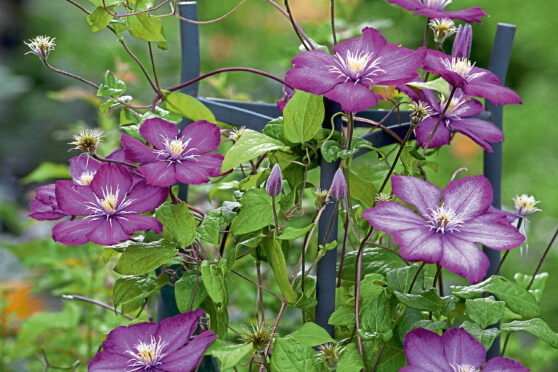
Jasmine, rose, pyracantha and clematis… a selection of climbers carefully positioned will brighten any garden, says our expert Agnes Stevenson
This week I’ve been battling with ground elder, digging out its persistent roots and chasing them back to where they disappear under the patio. They’ll be back but, for the moment, they’ve been vanquished and I can get on with planting up the area beneath the brick wall.
I have a mix of climbers on standby, including several pyracantha, a pink rose, several clematis and a jasmine to choose from. Admittedly I was being ambitious when I bought the jasmine, but this is the warmest and sunniest spot in the garden so I might just pull it off.
The space isn’t big enough to take all of these climbers, so I’ll have to whittle down my choice to two or three plants and the rest I’ll spread around the garden, placing them where they can scramble through shrubs and drape themselves from trees, such as the magnolia, which would benefit from brightening up now that its own flowers have long gone.
I’ve also been taking cuttings from a large Lonicera nitida, that I intend to use as a low hedge around the edge of the lawn. I would have preferred to use box, but this area can get damp and I think the lonicera will cope better with the conditions.
If you are growing any kind of hedge then you want it to be thick and dense so, instead of taking single cuttings, I’ve been taking bundles of four or five and placing these into small pots filled with a mixture of compost and horticultural grit.
Once they start growing properly I’ll water them with a diluted feed of liquid seaweed before moving them into bigger pots. Then, I’ll wait for them to grow large and strong enough to set out, hopefully next spring.
When spring comes
Talking about spring, it is worth noting that bulbs are arriving in garden centres and if you want to get the pick of the bunch then it is worth buying them as soon as possible. You can plant daffodils as soon as you get them home, but keep tulips somewhere cool and dry and don’t plant them until November at the earliest, by which time frost will hopefully have killed off any fungal diseases that could affect them.
When it comes to daffodils, I grow miniature varieties in pots. I raise some “Paperwhite” narcissi indoors and I like to naturalise species daffodils, such as Narcissus pseudonarcissus, in grass. However, when growing daffodils in the border, one variety stands head and shoulders above all the others.
Narcissus “Thalia” may be less than 50cm tall, but this triandrus-type, with its milky white flowers, is the most elegant of all daffodils and because of its small stature it fades away discretely as the plants around it start to grow.
I may add a few clumps of them beneath the new climbers and then wait for the early clematis to flower above them for a dazzling spring show.

Enjoy the convenience of having The Sunday Post delivered as a digital ePaper straight to your smartphone, tablet or computer.
Subscribe for only £5.49 a month and enjoy all the benefits of the printed paper as a digital replica.
Subscribe